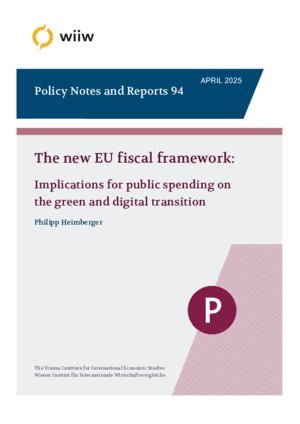The new EU fiscal framework: Implications for public spending on the green and digital transition
wiiw Policy Note/Policy Report No. 94, April 2025
21 pages including 1 Figure
This paper provides a critical assessment of the new EU fiscal framework, with a focus on its implications for public expenditure on the twin green and digital transition. According to the reformed rules, member states may commit to a package of investment and reform to extend the fiscal adjustment path from four years to a maximum of seven years, provided the European Commission agrees that the package meets predefined criteria, including the contribution to EU priorities (in particular, the European Green Deal and the EU digital strategy). However, the reformed framework does not provide any broad-based exemption for public investment in the twin transition, although the necessary large expansion in public assets is rather unlikely, given the requirement to reduce public liabilities relative to output over the medium term. This implies that, if member countries want to increase green and digital public spending, they will have to make room for it either by restraining other spending items (e.g. social protection, health or education) or by increasing taxes. A major fiscal consolidation will be required in a number of (big) euro area countries from 2025 onwards to comply with the reformed EU fiscal rules. However, the temporary exemption for additional defence spending will make the overall fiscal stance in EU countries more expansionary than it would otherwise have been. There is now a political focus in the EU on industrialisation through rearmament. The pressure to go for additional deficit-financed defence spending will, however, eventually raise the share of government interest payments in total tax revenue, and the political aversion to higher fiscal deficits must be expected to exert downward pressure on public spending on the green and digital transition. Against that background, this paper discusses three options for how to boost the fiscal space for the required additional public spending on the twin transition: implementing changes to key assumptions in the technical substructure of the new fiscal framework when it comes to assessing country-specific debt sustainability; expanding national co-financing of EU programmes; and introducing an EU investment fund for climate and digitalisation.
Keywords: Green transition, digital transition, EU fiscal rules, public investment, fiscal policy, austerity
JEL classification: H41, H54, H60
Countries covered: European Union
Research Areas: Macroeconomic Analysis and Policy
